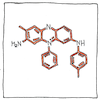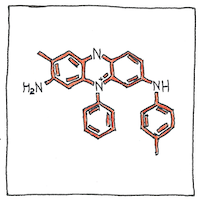William Henry Perkin
chemistry

|
Mauve
Experimenting with coal-tar distillates (benzene, toluene, naphthalene, anthracene) while trying to synthesize quinine, William Henry Perkin discovered a reddish brown powder that would dye silk purple, the royal color. Perkin convinced Scottish dyers to test it, and founded a company to manufacture it thus starting a major chemical industry made successful after Empress Eugénie decided that mauve matched the color of her eyes.
Unnatural desires
In our alchemist crucible we crudely imitate nature using intense heat and vicious catalysts to produce plastics, poisons, fertilizers, paints, dyes, and medicines more expensive than gold. Gradually the accumulation of unnatural residues thwarts the natural processes we rely on and our dreams become nightmares in which everything we touch, like the Midas curse, becomes toxic.
Halloween deceptions
Because it’s Halloween you enter the party blindfolded. At the door polyester fibers pull across your face. Someone takes your hand and pushes it into a bowl of grapes. If these are not spider webs if these are not human eyeballs if the mournful music you hear doesn’t make you apprehensive then playacting is indistinguishable from real life. but in real life when we remove a blindfold we find another blindfold under it. We poke at things in the dark to give unshapen forms angle and texture and it’s impossible not to imagine that things conform to our analogies. When the genuine is indistinguishable from a good fake, we are equally innocent.



Pragmatists such as William James dismissed differences that make no difference. Fakes can have value. For the sake of elephants, I would rather see piano keys made of plastic than ivory. But I complain when mass marketed products displace the artist and the artisan and when mass production poisons our planet.
See also in The book of science:
Readings in wikipedia: